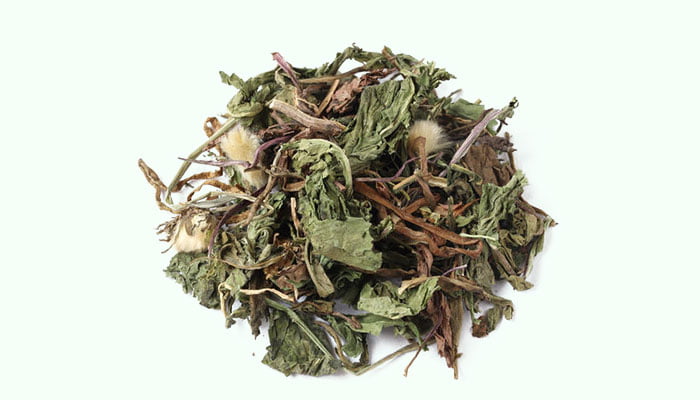What Is Pu Gong Ying
Pu Gong Ying is also known as Dandelion or Taraxacum, which is a perennial herb belonging to the family Asteraceae. It is a relatively common Chinese herbal medicine, which first appeared in <Tang Ben Cao> in 659 AD.
Dandelion comes from French dent-de-lion, which means the lion’s teeth and is used to describe the shape of the dandelion leaves.
There are about 2,000 species of this genus, most of which are distributed in temperate and subtropical regions of the Northern Hemisphere. The Pu Gong Ying referred to herein is Taraxacum mongolicum and Taraxacum borealisinense. All parts of these two plants can be made into medicine.

Taraxacum mongolicum is easy to reproduce and often grows on hillsides, grasslands, fields, and river beaches at medium or low altitudes. It is distributed in China, North Korea, Russia, Mongolia.
Taraxacum borealisinense often grows in a slightly humid saline land or field at an altitude of 300-2,900 meters. It is distributed in some countries in Asia.
Every summer and autumn, people gather all parts of Taraxacum mongolicum or Taraxacum borealisinense, wash them with water, cut them into sections, use them directly, or dry them in the sun, and make them into Chinese herbal medicines.
Pu Gong Ying contains luteolin, quercetin, apigenin, rutin, artemetin, genkwanin, hesperetin, hesperidin, taraxerol, taraxasterol, β-amyrin, α-amyrin, β-sitosterol, daucosterol, coumarin, organic acids, and volatile oils.
According to the Chinese Pharmacopoeia, the medicinal nature of Pu Gong Ying is relatively cold, with a bitter and sweet taste. It has a certain therapeutic effect on the pathological changes of the liver and stomach meridians.
In traditional Chinese medicine, it is often used to clear heat and remove toxins, alleviate swelling and dissipate nodulation, drain dampness and promote urination, treat acute mastitis, pulmonary abscess, acute appendicitis, acute jaundice hepatitis, cholecystitis, gastric and duodenal ulcers, pelvic inflammation, urinary stones, pediatric heat type constipation and a variety of infectious inflammation.
There are more than 200 kinds of traditional Chinese medicine prescriptions containing Pu Gong Ying, such as Fu Fang Qing Dai Wan, Zhen Zhu An Chuang Wan, and Chuan Xin Lian Kang Yan Pian.
Benefits
- Anti-inflammation, anti-oxidation, and anti-tumor.
- Enhancing macrophage phagocytosis and improving immunity.
- Inhibiting the accumulation of fat in the liver and protecting the liver.
- Inhibiting the activity of α-glucosidase and reducing blood sugar and blood lipids.
- Promoting bile secretion and inhibiting gastric acid secretion induced by histamine, pentagastrin, or carbamoylcholine.
- Promoting lactation, eliminating breast lumps, relieving breast swelling and pain, and treating acute mastitis.
- Removing heat toxins and relieving skin ulcers and carbuncles caused by heat toxins.
- Alleviating swelling and dissipating nodulation, treating pulmonary abscess and acute appendicitis.
- Draining dampness and treating jaundice caused by damp-heat.
- Promoting urination and relieving frequent urination, urgency, difficult and painful urination caused by damp-heat.
- Clearing liver heat, improving eyesight, and alleviating redness and swelling of the eyes caused by the up-flaming of liver fire.
- Inhibiting enterovirus 71, herpes simplex virus, hepatitis C virus, influenza A H1N1 virus.
- Inhibiting Staphylococcus aureus, Streptococcus haemolyticus, Diplococcus pneumoniae, Neisseria meningitidis, Diphtheria bacillus, F’s dysentery bacillus, Pseudomonas aeruginosa, and Leptospira.
- The topical application after mashing it can treat snake bites.
Combinations
- It can be used in combination with Shan Zha (Hawthorn Fruit), Sang Ji Sheng (Herba Taxilli), Huang Qi (Radix Astragali), Wu Wei Zi (Fructus Schisandrae), etc. to treat hyperlipidemia.
- It can be used in combination with Yu Xing Cao (Houttuynia Cordata), Dong Gua Zi (Winter Melon Seeds), Lu Gen (Rhizoma Phragmitis), etc. to treat the pulmonary abscess.
- It can be used in combination with Da Huang (Radix et Rhizoma Rhei), Fu Ling (Poria), Sha Ren (Fructus Amomi), etc. to treat superficial gastritis.
- It can be used in combination with Yin Chen (Herba Artemisiae Scopariae), Zhi Zi (Fructus Gardeniae), Da Huang (Radix et Rhizoma Rhei), etc. to treat jaundice caused by damp-heat.
- It can be used in combination with Ju Hua (Flos Chrysanthemi), Xia Ku Cao (Spica Prunellae), Huang Qin (Radix Scutellariae), etc. to treat redness and swelling of the eyes caused by the up-flaming of liver fire.
Side Effects
- At present, no data is showing that Pu Gong Ying has toxic effects.
- A small proportion of patients taking it may cause nausea, vomiting, abdominal discomfort, diarrhea, heartburn, itching, or urticaria.
- A small proportion of patients taking its medicinal liquor may cause dizziness, nausea, sweating, urticaria, or conjunctivitis. The symptoms will gradually disappear after stopping taking it.
- Intravenous infusion of dandelion injection in individual patients may cause shivers and pale faces.
- Intramuscular injection of dandelion injection may cause local pain.
Precautions and Warnings
- The dosage of Pu Gong Ying should be controlled between 9-15g.
- When using fresh Pu Gong Ying, the dose should be doubled.
- It can be made into decoctions, pills, powders, injections, or mashed for external use.
- People who are allergic to Pu Gong Ying should not take it.
- Patients with deep abscesses should not take it.
- Patients with no syndromes of excess heat should not take it.
- Patients with deficiency-cold in the spleen and stomach should not take it.
- Patients with loose stools and diarrhea should not take it.
- Pregnant women should not take it.
